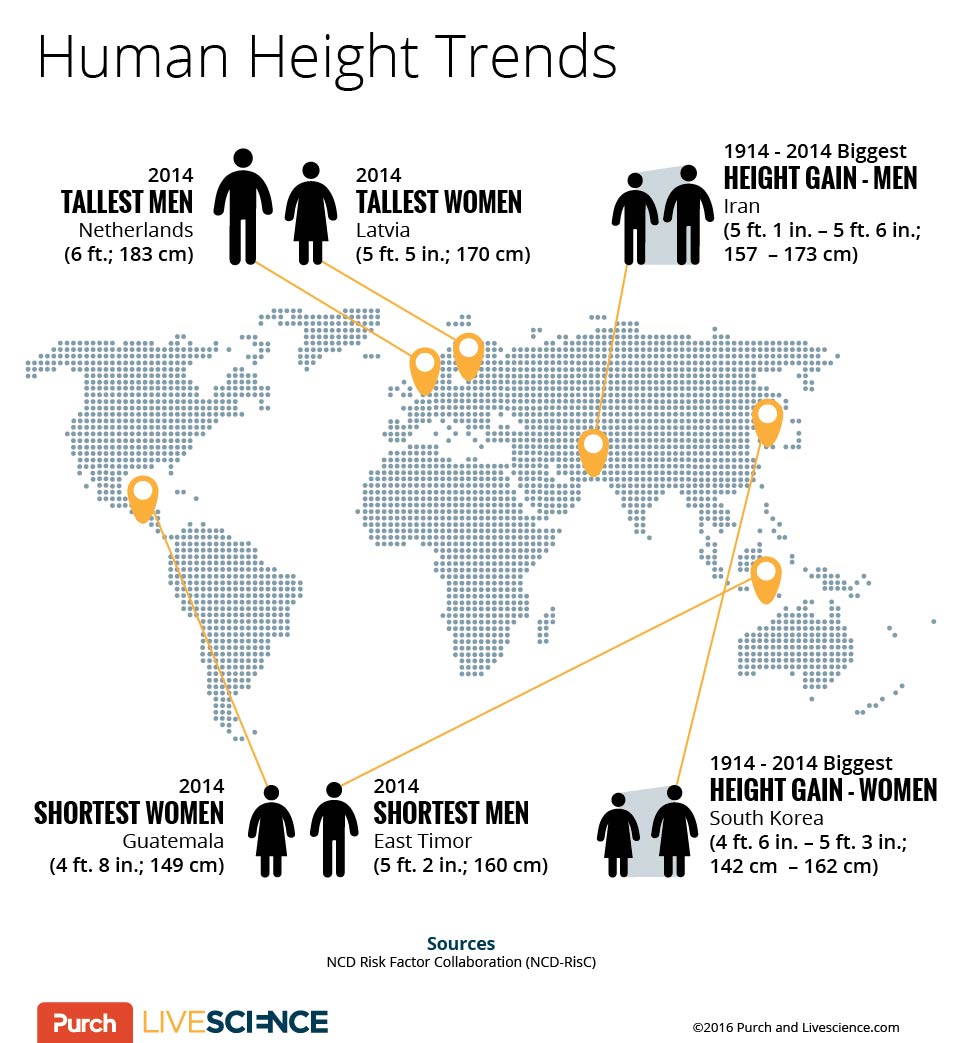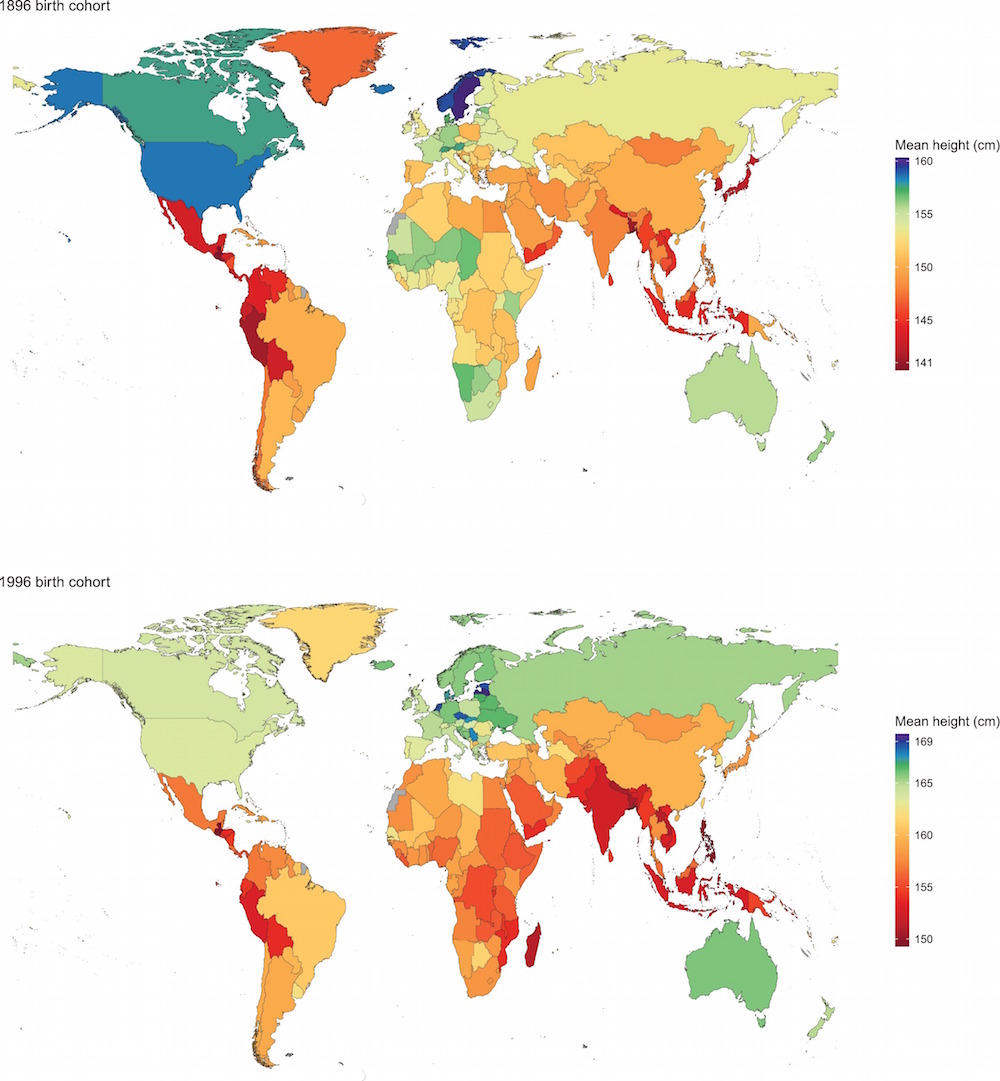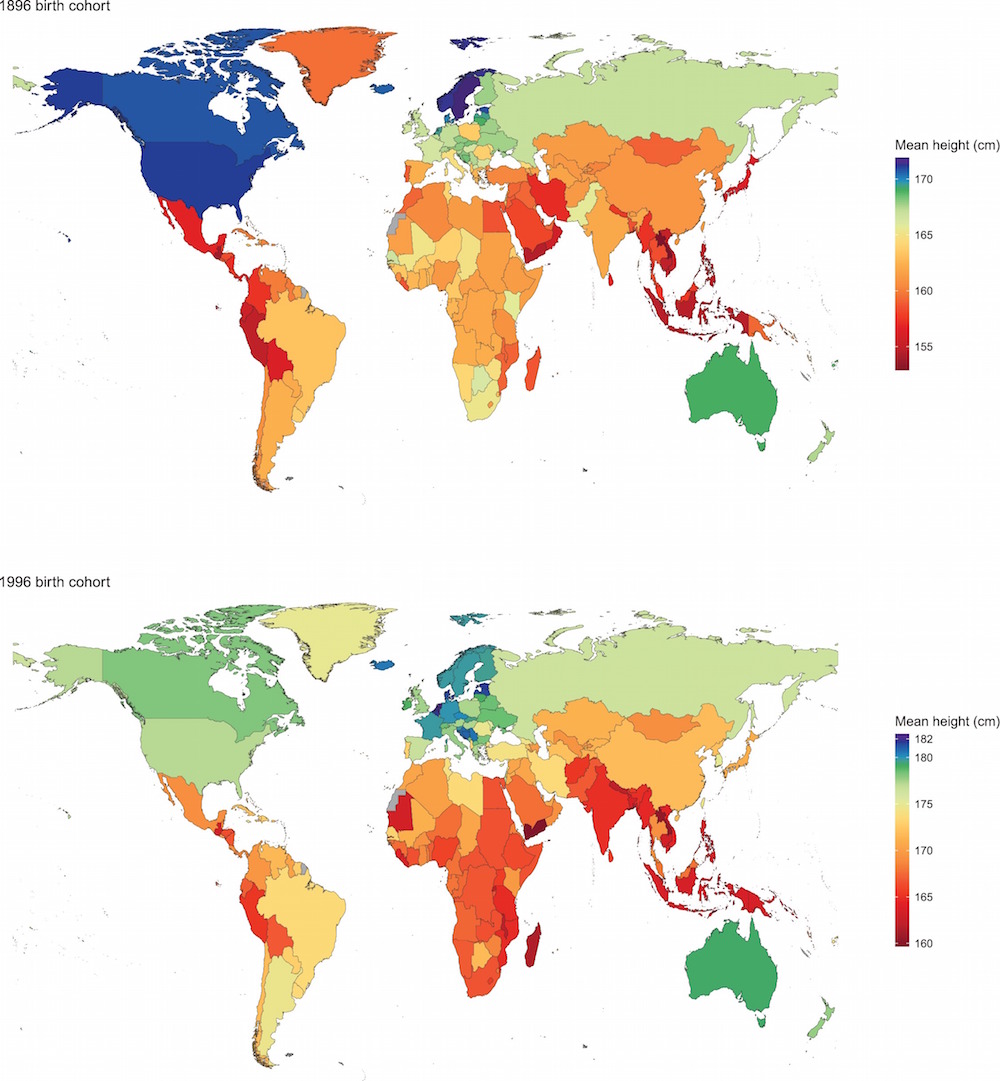Where Do the World’s Tallest and Shortest People Live?

The tallest men in the world live in the Netherlands, and the tallest women call Latvia home, according to the largest study ever done on people's heights.
The vast project included data from more than 1,400 previous studies that had the heights of more than 18.6 million people in 200 countries. These studies included the heights of people who were 18 during every year between 1914 and 2014, allowing the researchers of the new study to track changes in average heights over time.
They found, for instance, that South Korean women and Iranian men showed the largest increases in average height over the past 100 years, with South Korean women gaining an average of 8 inches (20.2 cm) between 1916 and 2014, and Iranian men growing an average of 6.5 inches (16.5 centimeters) taller. [Know Your Roots? Human Evolution Quiz]
Men and women in the United States also experienced a growth spurt, but to a lesser degree. In 1914, U.S. men were the third tallest in the world, and U.S. women were the fourth tallest. But despite increases in height of 2.2 inches and 2 inches (6 cm and 5 cm), respectively, U.S. men are now ranked 37th and women are ranked 42nd, the study found.

In the United Kingdom, both men and women have gained about 4.3 inches (11 cm) over the past 100 years, jumping from 57th to 38th place (for women) and 36th to 31th place (for men). In China, the stature of men and women has increased about 4.3 and 3.9 inches (11 cm and 10 cm), respectively, from 1914 to 2014.
In the modern world, the top 10 tallest nations are all in Europe, and none of them are English-speaking nations, the researchers found.
Roller-coaster trends

Some countries hit plateaus over the past 30 to 40 years, although they showed increases in height during the first half of the century, the researchers found.
Sign up for the Live Science daily newsletter now
Get the world’s most fascinating discoveries delivered straight to your inbox.
For instance, the United States plateaued, as did the United Kingdom, Finland and Japan. However, other countries, such as Spain, Italy and several Latin American and East Asian countries, are still increasing in height, they found.
In contrast, other countries, especially those in sub-Saharan Africa, North Africa and the Middle East, have actually seen declines in height over the past 30 to 40 years.
In these countries, the stagnation or decreases in height could be due to a mix of the wealthy people already receiving the maximum amount of nourishment and health care, and lower-class people getting subpar nutrition, especially during pregnancy, study co-author James Bentham, a research associate at the School of Public Health at Imperial College London, told Live Science.
Why height matters
People's height is partly determined by genetics, but nutrition and environmental factors also play a role, the researchers said. Because conditions such as childhood illness and poor nutrition during pregnancy and childhood can stunt growth, the average height of people can serve as a proxy for how healthy their nation is, the researchers said.

Moreover, being taller is associated with longevity, higher education and better earnings, the researchers wrote in the study. Tall people are also less likely to experience heart disease and stroke, and taller women and their children are less likely to have complications before and after childbirth, they said. [Blossoming Body: 8 Odd Changes That Occur During Pregnancy]
But it's not all rosy for tall people. Research shows that tall people are more likely to get some cancers, including colorectal, breast and ovarian cancers, and possibly pancreatic and prostate cancers, they said.
"This study gives us a picture of the health of nations over the past century, and reveals the average height of some nations may even be shrinking while others continue to grow taller," study lead researcher Majid Ezzati, a professor at the School of Public Health at Imperial College London, said in a statement. "This confirms we urgently need to address children and adolescents' environment and nutrition on a global scale, and ensure we’re giving the world's children the best possible start in life."
Ezzati added that the English-speaking world, especially the United States, "is falling behind other high-income nations in Europe and Asia Pacific." These differences in height, when combined with reports about increased obesity, could be a red flag about people's health, and emphasizes the need for better nutrition throughout life, he said.
The study was published online July 26 in the journal eLife.
Quick facts
- The average height of 18-year-old men has dropped by as much as 2 inches (5 cm) over the past 40 years in parts of Sub-Saharan Africa, including Sierra Leon, Uganda and Rwanda.
- Australia was the only non-European country to be in the top 25 in 2014; its men ranked No. 18 and its women ranked No. 15.
- In East Asia, South Korean and Chinese men are now taller than Japanese men.
- Adults in the South Asian countries of Bangladesh and India have heights that are plateauing, at about 2 to 4 inches (5 cm to 10 cm) shorter than adults in Japan and South Korea.
- The smallest men in 1914 lived in Laos, with an average height of 5 feet (153 cm), which is similar to the height of a well-nourished 12-year-old boy today.
- In 1914, the shortest women lived in Guatemala, with an average height of 4 feet 7 inches (140 cm), the same height as a well-nourished 10-year-old girl today.
The nations with the tallest men in 2014 (with their 1914 rankings given in brackets):
- Netherlands (12)
- Belgium (33)
- Estonia (4)
- Latvia (13)
- Denmark (9)
- Bosnia and Herzegovina (19)
- Croatia (22)
- Serbia (30)
- Iceland (6)
- Czech Republic (24)
The nations with the tallest women in 2014 (1914 ranking in brackets):
- Latvia (28)
- Netherlands (38)
- Estonia (16)
- Czech Republic (69)
- Serbia (93)
- Slovakia (26)
- Denmark (11)
- Lithuania (41)
- Belarus (42)
- Ukraine (43)
Original article on Live Science.

Laura is the archaeology and Life's Little Mysteries editor at Live Science. She also reports on general science, including paleontology. Her work has appeared in The New York Times, Scholastic, Popular Science and Spectrum, a site on autism research. She has won multiple awards from the Society of Professional Journalists and the Washington Newspaper Publishers Association for her reporting at a weekly newspaper near Seattle. Laura holds a bachelor's degree in English literature and psychology from Washington University in St. Louis and a master's degree in science writing from NYU.









